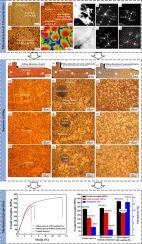Materials Characterization ( IF 4.7 ) Pub Date : 2021-01-12 , DOI: 10.1016/j.matchar.2021.110898 Yongkun Li , Lu Li , Baoyu Geng , Qiuping Wang , Rongfeng Zhou , Xing Wu , Han Xiao

|
Studies on the rheoforming of high melting point alloys are scarce due to the difficulties in preparing semisolid slurries. This work applied a novel enclosed cooling slope channel (ECSC) to prepare a semisolid slurry and squeeze cast a CuSn10P1 (weight percent) alloy. The microstructure and phase formation of the semisolid slurry, properties of liquid squeeze casting, rheo-squeeze casting with or without isothermal treatment of the semisolid slurry were investigated through X-ray diffraction, scanning electron microscopy, electron probe microanalysis, nanoindentation, and transmission electron microscopy. The results show that the microstructure is transformed from coarse dendrites of as-cast to equiaxed grains of semisolid. The high cooling rate of the ECSC process and the semisolid slurry isothermal treatment suppressed tin diffusion to induce the formation of the metastable phase β′-Cu13.7Sn. The average values of the modulus and micro-hardness of the rheo-squeeze part after soaking for 20 s were 121.99 ± 14.03 GPa and 2.01 ± 0.94 GPa, which was lower than that without isothermal and liquid squeeze casting, indicating that it has good deformability. The tensile strength and elongation of the rheo-squeeze part after 20 s of soaking treatment are 417 MPa and 12.6%, which increase by 26.3% and three times, respectively, compared to those without isothermal and liquid squeezing, which is likely attributed to solution strengthening, fine grain strengthening, and microstructure homogenization. In addition, the fracture mechanism was transformed from the brittle fracture of liquid squeeze and rheo-squeeze casting without isothermal treatment to a combination of cleavage fracture and ductile fracture of rheo-squeeze casting with 20 s of soaking treatment.
中文翻译:

半固态CuSn10P1合金的显微组织特征及强化机理
由于制备半固态浆料的困难,对高熔点合金的流变成形的研究很少。这项工作应用了新颖的封闭式冷却坡道(ECSC)来制备半固态浆料并挤压铸造CuSn10P1(重量百分比)合金。通过X射线衍射,扫描电子显微镜,电子探针显微分析,纳米压痕和透射电子研究了半固态浆料的微观结构和相形成,液体挤压铸造的性能,是否经过等温处理的流变挤压铸造性能。显微镜检查。结果表明,显微组织从铸态的粗枝晶转变为半固态的等轴晶。13.7锡 浸泡20 s后,流变挤压部件的模量和显微硬度的平均值分别为121.99±14.03 GPa和2.01±0.94 GPa,这比不进行等温和液态挤压铸造的情况要低,表明它具有良好的变形性。浸泡20 s后,流变挤压零件的抗拉强度和伸长率分别为417 MPa和12.6%,与没有等温和液体挤压的那些相比,分别增加了26.3%和3倍,这可能归因于固溶强化,细晶粒强化和微结构均质化。此外,


























 京公网安备 11010802027423号
京公网安备 11010802027423号